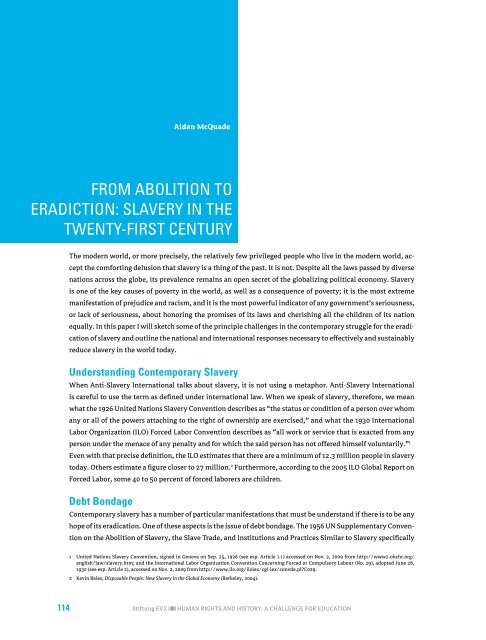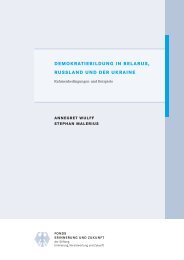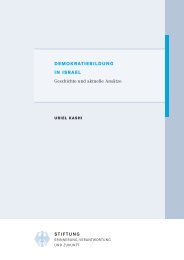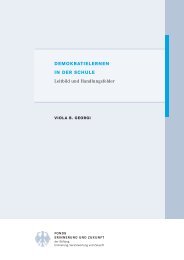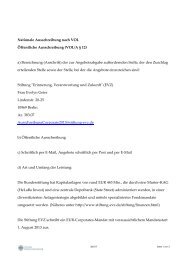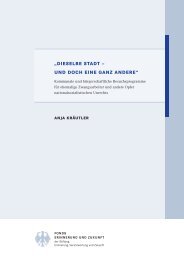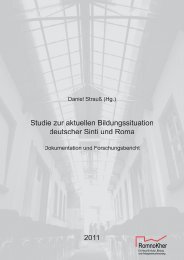chapter 2 - Stiftung "Erinnerung, Verantwortung und Zukunft"
chapter 2 - Stiftung "Erinnerung, Verantwortung und Zukunft"
chapter 2 - Stiftung "Erinnerung, Verantwortung und Zukunft"
You also want an ePaper? Increase the reach of your titles
YUMPU automatically turns print PDFs into web optimized ePapers that Google loves.
Aidan McQuade<br />
FROM ABOLITION TO<br />
ERADICTION: SLAVERY IN THE<br />
TWENTY-FIRST CENTURY<br />
The modern world, or more precisely, the relatively few privileged people who live in the modern world, accept<br />
the comforting delusion that slavery is a thing of the past. It is not. Despite all the laws passed by diverse<br />
nations across the globe, its prevalence remains an open secret of the globalizing political economy. Slavery<br />
is one of the key causes of poverty in the world, as well as a consequence of poverty; it is the most extreme<br />
manifestation of prejudice and racism, and it is the most powerful indicator of any government’s seriousness,<br />
or lack of seriousness, about honoring the promises of its laws and cherishing all the children of its nation<br />
equally. In this paper I will sketch some of the principle challenges in the contemporary struggle for the eradication<br />
of slavery and outline the national and international responses necessary to effectively and sustainably<br />
reduce slavery in the world today.<br />
Understanding Contemporary Slavery<br />
When Anti-Slavery International talks about slavery, it is not using a metaphor. Anti-Slavery International<br />
is careful to use the term as defined <strong>und</strong>er international law. When we speak of slavery, therefore, we mean<br />
what the 1926 United Nations Slavery Convention describes as “the status or condition of a person over whom<br />
any or all of the powers attaching to the right of ownership are exercised,” and what the 1930 International<br />
Labor Organization (ILO) Forced Labor Convention describes as “all work or service that is exacted from any<br />
person <strong>und</strong>er the menace of any penalty and for which the said person has not offered himself voluntarily.” 1<br />
Even with that precise definition, the ILO estimates that there are a minimum of 12.3 million people in slavery<br />
today. Others estimate a figure closer to 27 million. 2 Furthermore, according to the 2005 ILO Global Report on<br />
Forced Labor, some 40 to 50 percent of forced laborers are children.<br />
Debt Bondage<br />
Contemporary slavery has a number of particular manifestations that must be <strong>und</strong>erstand if there is to be any<br />
hope of its eradication. One of these aspects is the issue of debt bondage. The 1956 UN Supplementary Convention<br />
on the Abolition of Slavery, the Slave Trade, and Institutions and Practices Similar to Slavery specifically<br />
1 United Nations Slavery Convention, signed in Geneva on Sep. 25, 1926 (see esp. Article 1.1) accessed on Nov. 2, 2009 from http://www2.ohchr.org/<br />
english/law/slavery.htm; and the International Labor Organization Convention Concerning Forced or Compulsory Labour (No. 29), adopted June 28,<br />
1930 (see esp. Article 2), accessed on Nov. 2, 2009 from http://www.ilo.org/ilolex/cgi-lex/convde.pl?C029.<br />
2 Kevin Bales, Disposable People: New Slavery in the Global Economy (Berkeley, 2004).<br />
114<br />
<strong>Stiftung</strong> EVZ<br />
HUMAN RIGHTS AND HISTORY: A CHALLENGE FOR EDUCATION


